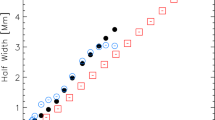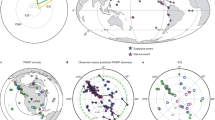Abstract
The subsurface structure of an “average” supergranule is derived using existing data products from the Helioseismic and Magnetic Imager (HMI) time–distance pipeline and compared to the best helioseismic flow model detailed by Duvall and Hanasoge (Solar Phys. 287, 71, 2013). We find that significant differences exist between them. Unlike the shallow structure predicted by the model, the average HMI supergranule is very extended in depth, exhibiting horizontal outflow down to 7 – 10 Mm, followed by a weak inflow reaching a depth of ≈ 20 Mm below the photosphere. The maximal velocities in the horizontal direction for the average supergranule are much lower than in the model, and its near-surface flow field RMS value is about an order of magnitude lower than the often-quoted values of ≈ 250 – 350 m s−1 for supergranulation. Much of the overall HMI supergranule structure and its weak flow amplitudes can be explained by examining the HMI pipeline averaging kernels for the near-surface inversions, which are found to be very broad in depth, and nearly identical to one another in terms of sensitivity along the z-direction. We also show that forward-modeled travel times in the Born approximation using the model (derived from a ray-theory approach) are inconsistent with measured travel times for an average supergranule at any distance. Our findings suggest systematic inaccuracies in the typical techniques used to study supergranulation, confirming some of the results of Duvall and Hanasoge (Solar Phys. 287, 71, 2013).

















Similar content being viewed by others
References
Benson, D., Stein, R., Nordlund, Å.: 2006, In: Leibacher, J., Stein, R.F., Uitenbroek, H. (eds.) Solar MHD theory and observations: a high spatial resolution perspective, Astronomical Society of the Pacific Conference Series 354, 92. ADS .
Birch, A.C., Gizon, L.: 2007, Astron. Nachr. 328, 228. DOI . ADS .
Birch, A.C., Kosovichev, A.G., Duvall, T.L. Jr.: 2004, Astrophys. J. 608, 580. DOI . ADS .
Birch, A., Duvall, T.L., Gizon, L., Jackiewicz, J.: 2006, Bull. Am. Astronom. Soc. 38, 224. ADS .
Christensen-Dalsgaard, J., Dappen, W., Ajukov, S.V., Anderson, E.R., Antia, H.M., Basu, S., Baturin, V.A., Berthomieu, G., Chaboyer, B., Chitre, S.M., Cox, A.N., Demarque, P., Donatowicz, J., Dziembowski, W.A., Gabriel, M., Gough, D.O., Guenther, D.B., Guzik, J.A., Harvey, J.W., Hill, F., Houdek, G., Iglesias, C.A., Kosovichev, A.G., Leibacher, J.W., Morel, P., Proffitt, C.R., Provost, J., Reiter, J., Rhodes, E.J. Jr., Rogers, F.J., Roxburgh, I.W., Thompson, M.J., Ulrich, R.K.: 1996, Science 272, 1286. ADS .
Couvidat, S., Zhao, J., Birch, A.C., Kosovichev, A.G., Duvall, T.L., Parchevsky, K., Scherrer, P.H.: 2012, Solar Phys. 275, 357. DOI . ADS .
DeGrave, K., Jackiewicz, J., Rempel, M.: 2014, Astrophys. J. 788, 127. DOI . ADS .
Duvall, T.L., Hanasoge, S.M.: 2013, Solar Phys. 287, 71. DOI . ADS .
Duvall, T.L., Hanasoge, S.M., Chakraborty, S.: 2014, Solar Phys. 289, 3421. DOI . ADS .
Duvall, T.L. Jr.: 1998, In: Korzennik, S. (ed.) Structure and Dynamics of the Interior of the Sun and Sun-Like Stars, SP-418, 581. ESA, Noordwijk. ADS .
Duvall, T.L. Jr., Birch, A.C.: 2010, Astrophys. J. Lett. 725, L47. DOI . ADS .
Duvall, T.L. Jr., Kosovichev, A.G., Scherrer, P.H., Bogart, R.S., Bush, R.I., de Forest, C., Hoeksema, J.T., Schou, J., Saba, J.L.R., Tarbell, T.D., Title, A.M., Wolfson, C.J., Milford, P.N.: 1997, Solar Phys. 170, 63. ADS .
Gizon, L., Birch, A.C.: 2002, Astrophys. J. 571, 966. DOI . ADS .
Hart, A.B.: 1954, Mon. Not. Roy. Astron. Soc. 114, 17. ADS .
Hart, A.B.: 1956, Mon. Not. Roy. Astron. Soc. 116, 38. ADS .
Hathaway, D.H., Beck, J.G., Bogart, R.S., Bachmann, K.T., Khatri, G., Petitto, J.M., Han, S., Raymond, J.: 2000, Solar Phys. 193, 299. DOI . ADS .
Hathaway, D.H., Beck, J.G., Han, S., Raymond, J.: 2002, Solar Phys. 205, 25. ADS .
Hirzberger, J., Gizon, L., Solanki, S.K., Duvall, T.L.: 2008, Solar Phys. 251, 417. DOI . ADS .
Jackiewicz, J., Gizon, L., Birch, A.C.: 2008, Solar Phys. 251, 381. DOI . ADS .
Kosovichev, A.G., Duvall, T.L. Jr.: 1997, In: Pijpers, F.P., Christensen-Dalsgaard, J., Rosenthal, C.S. (eds.) SCORe’96: Solar Convection and Oscillations and Their Relationship, Astrophys. Space Sci. Lib. 225, 241. Kluwer, Dordrecht. ADS .
Rieutord, M., Meunier, N., Roudier, T., Rondi, S., Beigbeder, F., Parès, L.: 2008, Astron. Astrophys. 479, L17. DOI . ADS .
Roudier, T., Švanda, M., Rieutord, M., Malherbe, J.M., Burston, R., Gizon, L.: 2014, Astron. Astrophys. 567, A138. DOI . ADS .
Simon, G.W., Leighton, R.B.: 1964, Astrophys. J. 140, 1120. DOI . ADS .
Williams, P.E., Pesnell, W.D., Beck, J.G., Lee, S.: 2014, Solar Phys. 289, 11. DOI . ADS .
Worden, S.P., Simon, G.W.: 1976, Solar Phys. 46, 73. DOI . ADS .
Zhao, J., Kosovichev, A.G.: 2003, In: Sawaya-Lacoste, H. (ed.) GONG+ 2002. Local and Global Helioseismology: The Present and Future, SP-517, 417. ESA, Noordwijk. ADS .
Zhao, J., Georgobiani, D., Kosovichev, A.G., Benson, D., Stein, R.F., Nordlund, Å.: 2007, Astrophys. J. 659, 848. DOI . ADS .
Zhao, J., Couvidat, S., Bogart, R.S., Parchevsky, K.V., Birch, A.C., Duvall, T.L., Beck, J.G., Kosovichev, A.G., Scherrer, P.H.: 2012, Solar Phys. 275, 375. DOI . ADS .
Acknowledgements
The authors gratefully acknowledge past support by the NASA SDO Science Center through contract NNH09CE41C awarded to NWRA, and helpful discussions with Junwei Zhao, Tom Duvall Jr., and Matthias Rempel. The data used here are courtesy of NASA/SDO and the HMI Science Team, whom we thank for their dedicated work. K. DeGrave also acknowledges funding from NSF award NSF/AGS-1351311 and sub-award AURA/NSO No. N06504C-N.
Author information
Authors and Affiliations
Corresponding author
Ethics declarations
Disclosure of Potential Conflicts of Interest
The authors declare that they have no conflicts of interest.
Appendix: Mass Conservation of the Various Flow Features
Appendix: Mass Conservation of the Various Flow Features
The average HMI and RSG1 features were checked to see how well their flows conserve mass relative to the various models described throughout this work. We did this by expanding the continuity equation (term A in Equation (1)) into its separate horizontal and vertical components (terms B and C, respectively) assuming a time-independent Model S density profile (Christensen-Dalsgaard et al., 1996) that only varies in the z-direction:
The model supergranules are constructed analytically to be mass conserving, although evaluate numerically to some small non-zero value due to numerical gradients and machine precision. As such, we checked mass conservation by calculating terms B and C within a 30 Mm radius of cell center and integrating them along all three spatial dimensions. Their ratios were then taken with respect to (B+C). In the case of a mass-conserving flow, the ratios (B+C)/B and (B+C)/C should be of the same magnitude and of opposite sign. The mass-conservation ratios for each feature are presented in Table 3. As expected, DH2, RSG2, and the BFM all satisfy continuity to a high precision. The HMI and RSG1 supergranules, to varying degrees, do not.
Rights and permissions
About this article
Cite this article
DeGrave, K., Jackiewicz, J. Helioseismic Investigation of Modeled and Observed Supergranule Structure. Sol Phys 290, 1547–1568 (2015). https://doi.org/10.1007/s11207-015-0693-0
Received:
Accepted:
Published:
Issue Date:
DOI: https://doi.org/10.1007/s11207-015-0693-0




